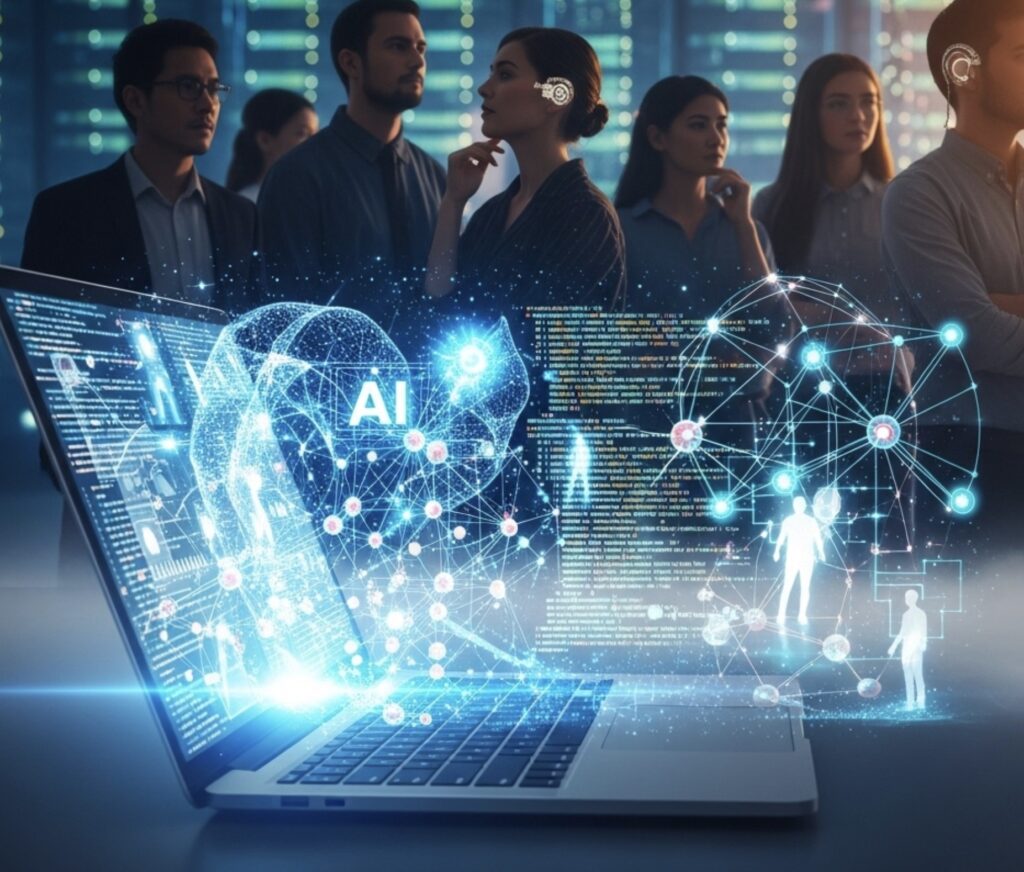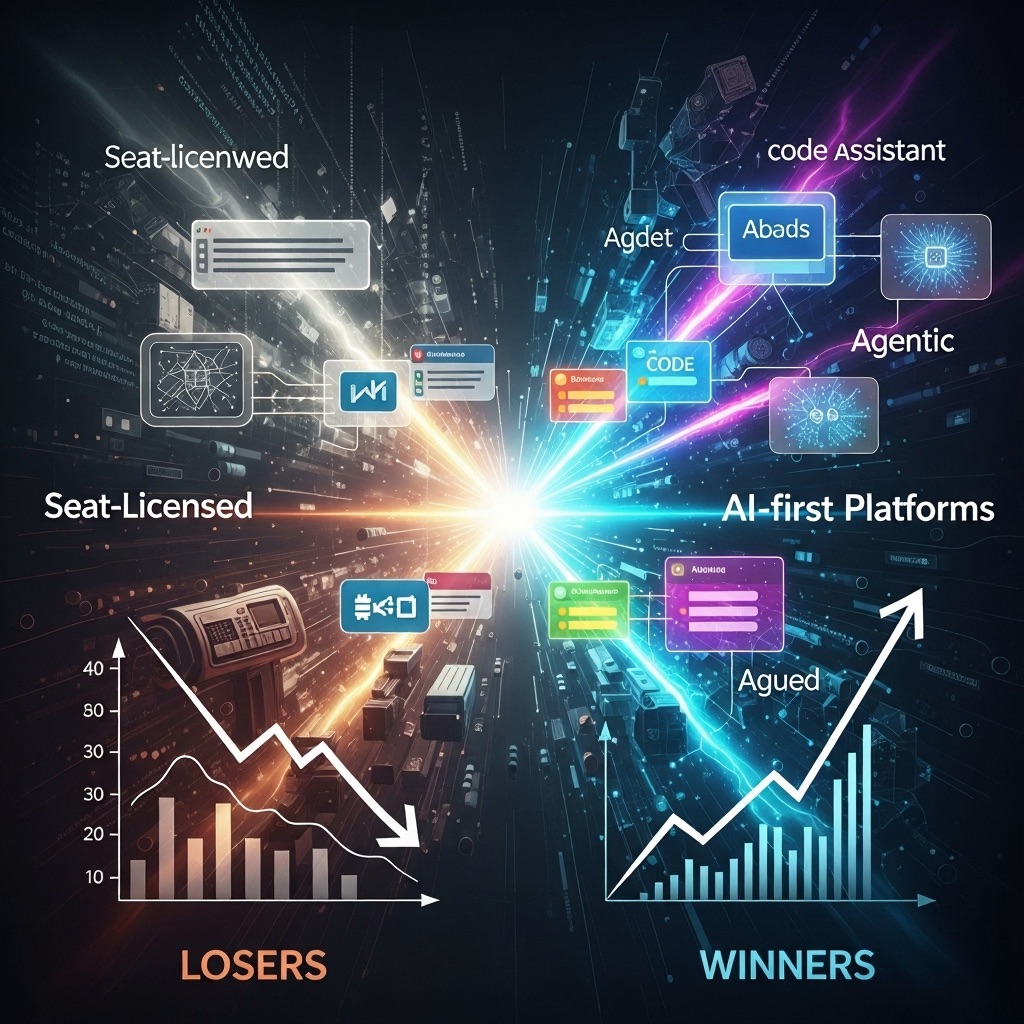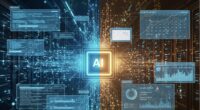Artificial intelligence is dramatically reshaping the software industry, creating clear winners and losers as technology advances at unprecedented speed. In 2025, the center of gravity has shifted from traditional seat‑licensed software toward AI‑first platforms, code assistants, and agentic systems. Valuations and expectations are being repriced in real time: a widely watched Morgan Stanley software basket is down to ~23× forward earnings—about half its decade average—even as the Nasdaq 100 still trades near 27×. That gap captures a nervous new consensus: AI isn’t just another feature; it may upend how software is built, priced, and bought.
The Rise of AI Coding
A flood of “AI that writes software” has moved from demos to daily work. GitHub Copilot’s enterprise push, Microsoft’s autonomous task tools, Google’s Gemini Code Assist for teams, and Amazon’s Q Developer (folding CodeWhisperer into a broader SDLC assistant) are shifting the developer’s job from manual authoring toward specifying, supervising, and hardening AI‑generated code. These are not prototypes; they’re supported and deployed products aimed squarely at production pipelines.

Industry commentary has raced further. An Elektor Magazine analysis captured the bullish thesis succinctly, highlighting forecasts that AI systems could surpass typical human coding performance by late 2025, with developers increasingly acting as “collaborative partners” guiding AI. While opinionated, that piece neatly describes the new workflow many teams are piloting.
But the evidence is not one‑way hype. A July 2025 randomized field study on experienced open‑source developers found that, on average, current AI tools slowed task completion by ~19%, with quality effects mixed—underscoring that “AI coding” is powerful but uneven, and that process integration matters as much as model strength. METR’s synthesis of that study reaches similar cautionary conclusions.
Winners and Losers
Winners. Platforms with distribution, data, and cloud leverage have been bid up as AI enablers:
- Microsoft crossed $4T in market cap this year, underpinned by Azure’s AI run‑rate and a Copilot strategy embedded across the suite. Reuters
- Oracle has rallied to record highs as investors treat its Gen2 Cloud and database footprint as a beneficiary of training/inference workloads. Reuters+1
- Palantir repeatedly raised guidance on surging AI demand in both commercial and government, becoming one of 2025’s top S&P 500 performers despite valuation concerns. Reuters+1
- Meta is spending heavily to scale AI infrastructure and partnerships (e.g., telco data‑center deals), fueling its AI‑product roadmap and investor optimism. Reuters
Under pressure. Meanwhile, marquee SaaS names have stumbled as buyers reassess willingness to pay premium seat prices when AI may automate chunks of the workflow those seats once justified:
- Salesforce (CRM): ~–27% YTD as of Aug 25, 2025 (Reuters key‑metrics), with debates over the pace of Agentforce monetization. Reuters+1
- Adobe (ADBE): ~–21% YTD as investors question the near‑term revenue lift from Firefly and AI features despite higher guidance. Reuters+1
- Atlassian (TEAM): ~–12% YTD, reflecting slower seat growth and a long road to deeply embedding AI agents across the portfolio. Reuters
The selling isn’t confined to the U.S. European software names (SAP, Dassault Systèmes, Sage, Nemetschek) also saw sharp drawdowns in mid‑August on “AI pitfalls” worries, signaling this is a sector‑wide repricing, not an idiosyncratic U.S. story. Reuters
Analyst and Industry Warnings
Caution has come from the inside. In an August interview, OpenAI’s CEO Sam Altman said plainly that AI is in a bubble, likening investor behavior to the late‑1990s dot‑com era—even as he argued the underlying technology is epochal. That duality (transformative tech + unstable expectations) captures 2025’s mood. The Verge
On Wall Street, RBC Capital Markets has urged clients to distinguish AI‑native from AI‑enabled vendors and to prepare for agents that could replace packaged SaaS in many workflows over time—a reframing often (mis)quoted as “the death of software,” but better read as a shift in software’s definition. Morgan Stanley’s commentary likewise flags capital‑spending concentration, overcapacity risk, and a valuation regime still adjusting to AI’s true economics. RBC Capital MarketsMorgan Stanley
A Market Reset (and What It’s Telling Us)
The iShares Expanded Tech‑Software ETF (IGV) illustrates 2025’s stop‑and‑go: a strong early‑year pop gave way to choppiness as investors digested slower AI monetization and debated whether incumbents can defend moats against cheaper, narrower AI tools. Importantly, valuation markers have reset: the Morgan Stanley software basket at ~23× forward earnings is half its decade average and below the Nasdaq 100’s multiple—evidence that investors now demand clearer ROI before paying up. Breakingviews adds that SaaS multiples still may not fully reflect AI’s threat to predictable subscription models. Yahoo FinanceReuters
Compounding the skepticism: an MIT‑led survey suggests ~95% of organizations report no measurable ROI yet from generative‑AI projects—classic “installation phase” dynamics where productivity gains lag investment. That helps explain why software has underperformed glamour AI hardware at times and why pullbacks have been so violent. The New YorkerFinancial Times
Strategic Uncertainty: What Will Determine the Next Decade’s Winners?
- Data and distribution moats. Owning proprietary data and controlling the “last mile” into workflows (IDEs, office suites, CRMs, ERPs) lets platforms plug AI directly where work happens. That’s why Microsoft’s and Google’s code assistants matter strategically: they sit in the developer’s loop by default. ReutersGoogle Cloud
- Agentic software, not AI features. RBC’s framing is useful: over years, buyers may “hire agents” (for sales ops, support, HR) rather than buy monolithic apps plus add‑ons. Incumbents that re‑architect around agents—with policy controls, auditability, and SLAs—can protect revenue; laggards risk declining seat counts. RBC Capital Markets
- Pricing model evolution. If value shifts from users to work done, pricing must migrate from per‑seat to usage/outcome‑based. Expect margin volatility before new models stabilize, one reason multiples are compressing now. Reuters
- Secure, governed SDLC. Enterprise adoption hinges on secure code generation, reproducibility, IP indemnity, and fine‑grained controls—areas where Gemini Code Assist Enterprise and Amazon Q Developer explicitly compete. Vendors that make AI development governable will see faster production uptake. Google CloudAmazon Web Services, Inc.
- Reality‑checked productivity. The OS‑developer RCT showing slower delivery with AI this spring should temper “full automation by year‑end” narratives. Teams that re‑engineer process (pairing, review gates, test harnesses, prompt repositories) will bank the gains; those that simply “turn it on” may not.
The Irony of Innovation
There’s a paradox at the heart of 2025: the industry that invented modern AI is one of its first casualties. Some long‑admired software franchises are discovering that AI can commoditize the very workflows they premium‑priced, while platform‑scale players and defense‑oriented AI firms soak up the upside. Yet “software’s death” is the wrong lesson. As RBC argues, software is changing form—from apps you rent to agents you direct. The winners will be those who adapt the quickest: rebuilding products around agents, proving ROI, and aligning pricing to outcomes. Everyone else will be repriced by a market that now rewards innovation over tradition. RBC Capital MarketsReuters
Notes on sources and evidence
- Market repricing & volatility: Morgan Stanley software‑basket valuation context and SaaS‑model pressure (Breakingviews). Yahoo FinanceReuters
- YTD performance: Reuters key‑metrics pages for CRM (≈–27%), ADBE (≈–21%), TEAM (≈–12%) as of Aug 25–26, 2025. Reuters+2Reuters+2
- Winners: Microsoft ($4T milestone), Oracle (record highs), Palantir (raised FY guidance). Reuters+3Reuters+3Reuters+3
- AI bubble: Sam Altman’s remarks. The Verge
- AI coding: products vs. promises: Copilot adoption, Microsoft’s autonomous tools, Gemini Code Assist, Amazon Q Developer, and Elektor’s (opinion) forecast; counter‑evidence from METR/arXiv RCT. Reuters+1Google CloudAmazon Web Services, Inc.Elektor
Bottom line: AI is not a bolt‑on feature. It is a new abstraction layer for work. In that shift, software’s leaders will be the firms that (1) own distribution, (2) weaponize data responsibly, (3) productize agents with governance, and (4) reprice around outcomes. The rest will look expensive until they prove otherwise.








